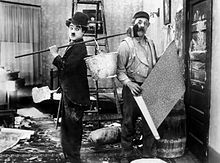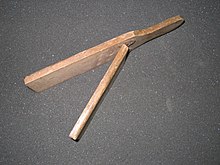Slapstick


Slapstick is a style of humor involving exaggerated physical activity that exceeds the boundaries of normal physical comedy.[1] Slapstick may involve both intentional violence and violence by mishap, often resulting from inept use of props such as saws and ladders.[2][3]
The term arises from a device developed for use in the broad, physical comedy style known as commedia dell'arte in 16th-century Italy. The "slap stick" consists of two thin slats of wood, which makes a "slap" when striking another actor, with little force needed to make a loud—and comical—sound. The physical slap stick remains a key component of the plot in the traditional and popular Punch and Judy puppet show. More contemporary examples of slapstick humor include The Three Stooges, The Naked Gun and Mr. Bean.
Origins
[edit]The name "slapstick" originates from the Italian batacchio or bataccio—called the "slap stick" in English—a club-like object composed of two wooden slats used in commedia dell'arte. When struck, the Batacchio produces a loud smacking noise, though it is only a little force that is transferred from the object to the person being struck. Actors may thus hit one another repeatedly with great audible effect while causing no damage and only very minor, if any, pain. Along with the inflatable bladder (of which the whoopee cushion is a modern variant), it was among the earliest special effects.
Early uses
[edit]
Slapstick comedy's history is measured in centuries. Shakespeare incorporated many chase scenes and beatings into his comedies, such as in his play The Comedy of Errors.
In early 19th-century England, pantomime acquired its present form which includes slapstick comedy: its most famous performer, Joseph Grimaldi—the father of modern clowning—"was a master of physical comedy".[4] Comedy routines also featured heavily in British music hall theatre which became popular in the 1850s.[5][6]
In Punch and Judy shows, which first appeared in England on 9 May 1662, a large slapstick is wielded by Punch against the other characters.[7]
Fred Karno
[edit]
British comedians who honed their skills at pantomime and music hall sketches include Charlie Chaplin, Stan Laurel, George Formby and Dan Leno.[8][9] The influential English music hall comedian and theatre impresario Fred Karno developed a form of sketch comedy without dialogue in the 1890s, and Chaplin and Laurel were among the young comedians who worked for him as part of "Fred Karno's Army".[8] Chaplin's fifteen-year music hall career inspired the comedy in all his later film work, especially as pantomimicry.[10] In a biography of Karno, Laurel stated: "Fred Karno didn't teach Charlie [Chaplin] and me all we know about comedy. He just taught us most of it".[11] American film producer Hal Roach described Karno as "not only a genius, he is the man who originated slapstick comedy. We in Hollywood owe much to him."[12]
In film and television
[edit]Building on its later popularity in the 19th and early 20th-century ethnic routines of the American vaudeville house, the style was explored extensively during the "golden era" of black and white movies directed by Hal Roach and Mack Sennett that featured such notables as Charlie Chaplin, Mabel Normand, Abbott and Costello, Laurel and Hardy, the Three Stooges, and Larry Semon. The "pie in the face" gag, in which one person hits another with a pie, became common in this era.[13] Silent slapstick comedy was also popular in early French films and included films by Max Linder, Charles Prince, and Sarah Duhamel.[14]

Slapstick also became a common element in animated cartoons starting in the 1930s and 1940s; examples include Disney's Mickey Mouse and Donald Duck shorts, Walter Lantz's Woody Woodpecker, the Beary Family, MGM's Tom and Jerry, the unrelated Tom and Jerry cartoons of Van Beuren Studios, Warner Bros. Looney Tunes/Merrie Melodies, MGM's Barney Bear, and Tex Avery's Screwy Squirrel. Slapstick was later used in Japanese Tokusatsu TV Kamen Rider Den O, Kamen Rider Gaim, Kamen Rider Drive, by Benny Hill in The Benny Hill Show in the UK, and in the US used in the three 1960s TV series, Gilligan's Island, Batman, The Flying Nun and I Love Lucy.[citation needed] In the 1970s, the sitcom Three's Company featured slapstick infused scenes in most episodes.
20th century fad
[edit]Use of the slapstick in public places was a fad in the early 20th century.[citation needed]
During the 1911 Veiled Prophet Parade in St. Louis, according to the St. Louis Post-Dispatch,[15]
The slapstick, so long indispensable to low comedy, found a new use among the crowds ... they used the slapstick to the extreme embarrassment of many women. The carnival spirit, for the most part tempered by high good humor, at times verged on rowdyism. Girls used a stick ripped with feathers to tickle the faces of young men, and they retaliated vigorously with the slapstick.
An editorial in the Asbury Park Press, New Jersey, said in 1914:[16]
Slapsticks are the latest "fun-making" fad for masque fetes ... Orders to stop the slapstick nuisance should be issued by the police and the Asbury Park carnival commissioners. Any device that cannot be operated or used without inflicting unmerited pain and injury should be excluded ...
See also
[edit]- Slapstick Festival
- List of slapstick comedy topics
- Slapstick film
- Cartoon violence
- Stage combat
- Schadenfreude
- Harisen, a paper fan used by the Japanese for a similar purpose.
References
[edit]- ^ "slapstick - definition of slapstick by the Free Online Dictionary, Thesaurus and Encyclopedia". Thefreedictionary.com. Retrieved 2013-04-29.
- ^ King, Rob (2017). Hokum!: The Early Sound Slapstick Short and Depression-Era Mass Culture. Oakland, California: University of California Press. p. 197.
- ^ "Slapstick comedy definition of Slapstick comedy in the Free Online Encyclopedia". Encyclopedia2.thefreedictionary.com. Retrieved 2013-04-29.
- ^ McRobbie, Linda Rodriguez (July 31, 2013). "The History and Psychology of Clowns Being Scary". Smithsonian Magazine. Retrieved 26 Nov 2024.
- ^ David Christopher (2002). British Culture: An Introduction. p. 74. Routledge,
- ^ Jeffrey Richards (2014). The Golden Age of Pantomime: Slapstick, Spectacle and Subversion in Victorian England. I.B.Tauris,
- ^ Miller, Judith (2017). Miller's Antiques Handbook & Price Guide 2018-2019. Hachette UK. p. 351.
- ^ a b McCabe, John. "Comedy World of Stan Laurel". p. 143. London: Robson Books, 2005, First edition 1975
- ^ "Enjoy Cumbria – Stan Laurel". BBC. Retrieved 2 January 2015
- ^ St. Pierre, Paul (2009). Music Hall Mimesis in British Film, 1895–1960: On the Halls on the Screen. Associated University Press. p. 38.
- ^ Burton, Alan (2000). Pimple, pranks & pratfalls: British film comedy before 1930. Flicks Books. p. 51.
- ^ J. P. Gallagher (1971). "Fred Karno: master of mirth and tears". p. 165. Hale.
- ^ King, Rob (December 2007). "SLAPSTICK AND MIS-REMEMBRANCE". New Review of Film and Television Studies. 5 (3): 333–351. doi:10.1080/17400300701670659. ISSN 1740-0309.
- ^ Maggie Hennefeld "Specters of Slapstick and Silent Film Comediennes", Columbia UP, 2018.
- ^ Martyn, Marguerite (October 4, 1911). "Great Crowds Lined Streets to See Pageant and Make Merry". St. Louis Post-Dispatch. Image 11 – via Newspapers.com.
- ^ "[No headline]". Asbury Park Press. New Jersey. July 20, 1914. column 2 – via Newspapers.com.
External links
[edit] The dictionary definition of slapstick at Wiktionary
The dictionary definition of slapstick at Wiktionary
